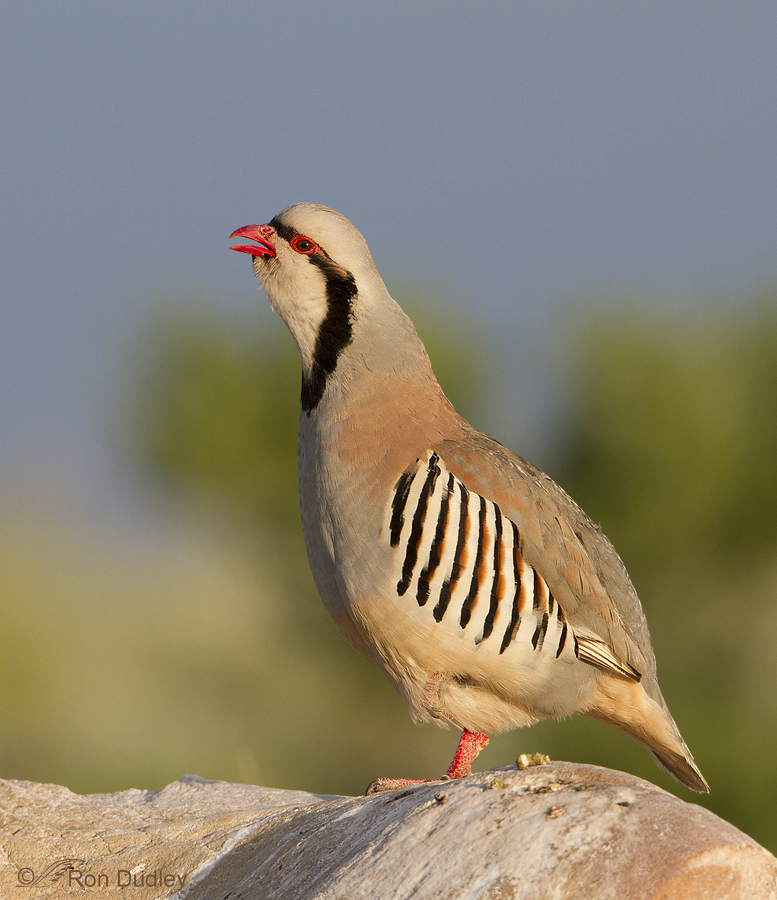Chukars continue to be one of my preferred subjects during the winter and spring due to their distinctive and colorful plumage and their often comical behavior. They are abundant on Antelope Island and even somewhat approachable there – at least in comparison to their skittish and wily ways elsewhere (hunters consider them to be among the most challenging of upland game species).
During summer and early fall I seldom photograph them because of their extended molt which makes them less than ideal subjects (and that’s a huge understatement).
1/1600, f/7.1, ISO 500, 500 f/4, natural light
I found this bird last May as it attempted to warm up and wake up in the early morning sun. Unlike the rest of the year, during spring Chukars spend much of their time calling from elevated perches, usually rocks. This bird amused me because it appeared to be quite sleepy so when it would hear another Chukar calling off in the distance it could barely summon up the enthusiasm to respond in kind. Here it maintained its one-footed stance as it called back briefly and then promptly closed its eyes again. I like the one curled toe peeking out of the lower belly feathers. Some may not particularly appreciate the excrement below the bird but hey, poop happens…
For anyone interested, here’s a link to their call.
I find it interesting that Chukars, a species introduced to North America for hunting purposes, are heavy consumers of cheatgrass – a noxious weed that has invaded our western grasslands and displaced native plants. They eat both the cheatgrass seeds and the green shoots. In fact the relationship between Chukars and cheatgrass is so intertwined that game managers believe the Chukar introduction in North America would have failed without the grass.
What a tangled web we weave…
Ron



chukar is really nice bird i like his sound
Love the link to their sound – which surprised me. Strangled chook is not the way I had imagined their call.
And which of us hasn’t been got up too early, and just done what absolutely HAS to be, while trying hard to doze off again.
Thank you for today’s Beagle Boy.
I love this shot. This bird looks like I’m feeling this morning… His lack of enthusiasm is palpable.
What an amazing shot Ron! I guess that’s one species that has worked out well. Many other plants and animals that have been imported, have not. We have in St. Louis another that seems to have worked out well and that’s the Eurasian tree sparrow which was introduced here in St. Louis, Mo in the mid 1800’s, Thanks so much for sharing!
Charlotte
I can identify with this bird…I feel the same way this morning….
Yes. We have tons of Huns here in Central MT. Hahaha I like them too as well as Sharptails. When the thermometer dips way below zero the Sharpies come to town & hang out in the trees. I guess because it’s warmer in town. I’ve counted as many as 40 in my fir & elm trees. They are so funny, they look like big chickens in trees!
Being from Oregon originally this is one of the species I miss seeing along with Quail. I guess there are trade offs for everything though. I’m not willing to leave Montana now that I’m here. I hear there is a growing population of Quail in the Bitterroot now. So anyway, getting back to Chukars. Do you think if cheat grass weren’t around (not likely) they would survive? Cute pic Ron & I don’t mind the poop!
I don’t know for sure if they would survive without cheatgrass, Deb but from what I’ve been reading I doubt it. In many areas of the west cheatgrass is their primary food. Interestingly, one other introduced upland game bird also relies heavily on cheatgrass – the Gray Partridge (old name Hungarian Partridge). We had lots of them on our Montana farm, though there wasn’t much cheatgrass there because most of the land was farmed. Bet you see “Huns” where you live too…